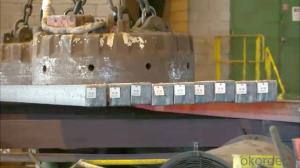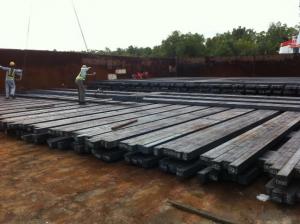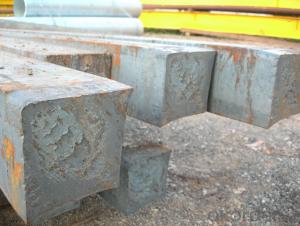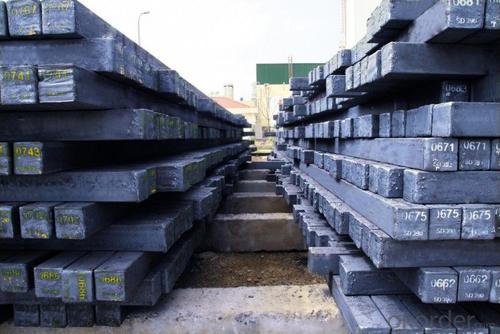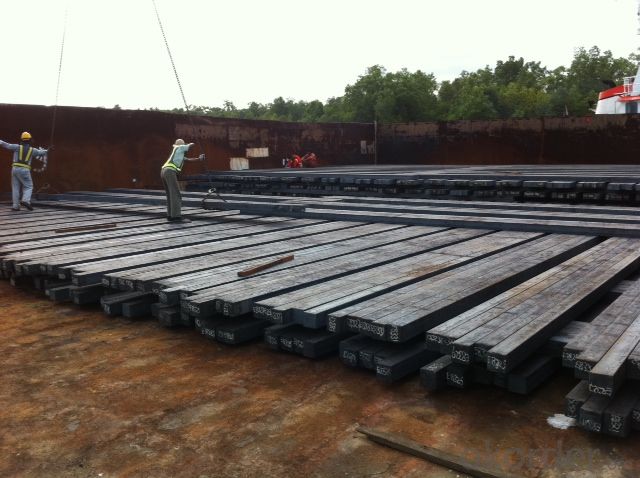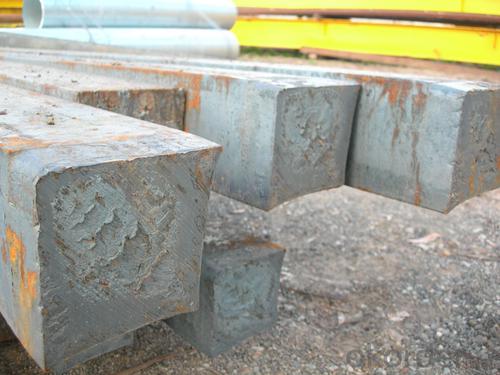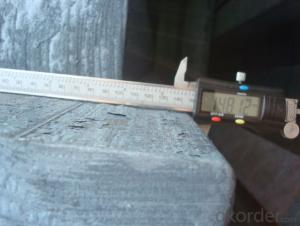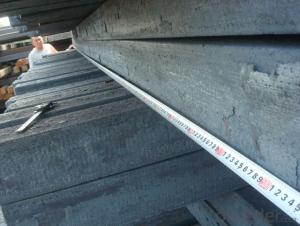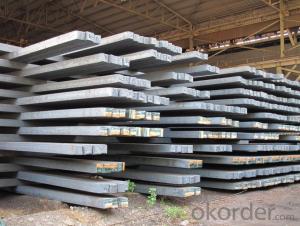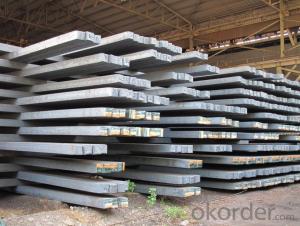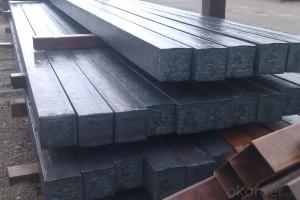Hot Rolled Square Steel Billet 3SP Standard 145mm
- Loading Port:
- Shanghai
- Payment Terms:
- TT OR LC
- Min Order Qty:
- 2000 m.t.
- Supply Capability:
- 10000 m.t./month
OKorder Service Pledge
OKorder Financial Service
You Might Also Like
Structure of Hot Rolled Square Steel Billet 3SP Standard 145mm

Description of Hot Rolled Square Steel Billet 3SP Standard 145mm
PPGI is made by cold rolled steel sheet and galvanized steel sheets as baseplate, through the surface pretreatment (degreasing, cleaning, chemical conversion processing), coated by the method of continuous coatings (roller coating method),
and after roasting and cooling. Zinc coating: Z60, Z80, Z100, Z120, Z180, Z275, G30, G60, G90
Alu-zinc coating: AZ60, AZ80, AZ100, AZ120, AZ180, G30, G60, G90
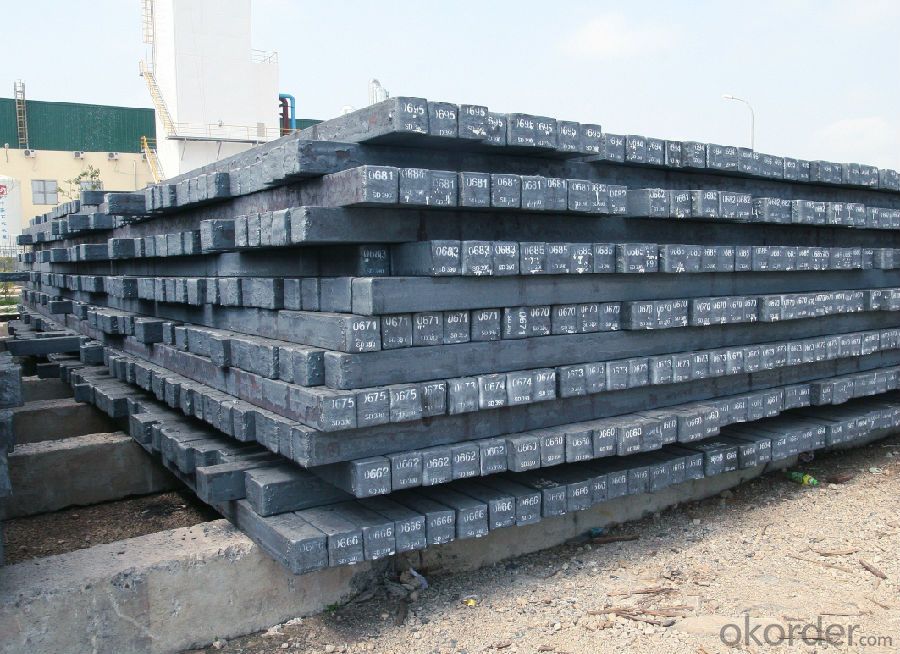
Main Feature of Hot Rolled Square Steel Billet 3SP Standard 145mm
1) Excellent corrosion resistance: The zinc layer provides a good protection of Pre-painted Galvanizeed Steel Sheet.
2) High heat resistance: The reflective surface of the material aids in efficiently reflecting the sunlight away and in turn reducing the amount of heat transmitted. The thermal reflectivity converts into energy savings.
3) Aesthetics: Pre-Painted Galvanized steel sheet is available in plethora of patterns and multiple sizes as per the requirements that given by our customers.
4) Versatility: can be used in the various areas.Standard seaworthy export packing: 3 layers of packing, inside is kraft paper, water plastic film is in the middle and outside GI steel sheet to be covered by steel strips with lock, with inner coil sleeve.
Applications of Hot Rolled Square Steel Billet 3SP Standard 145mm
1) Automotive bodies: filters, fuel tanks, etc.
2) Construction materials: roofings, welding pipes,
3) Electric and electronic appliances: computer cans, etc.
4) Steel cans: containers, etc.
5) Steel furniture: washing machines, refrigerators, microwaves, etc.
6) Drums
7) Office equipment: printer, recorders, etc.
8) Motors and transformers
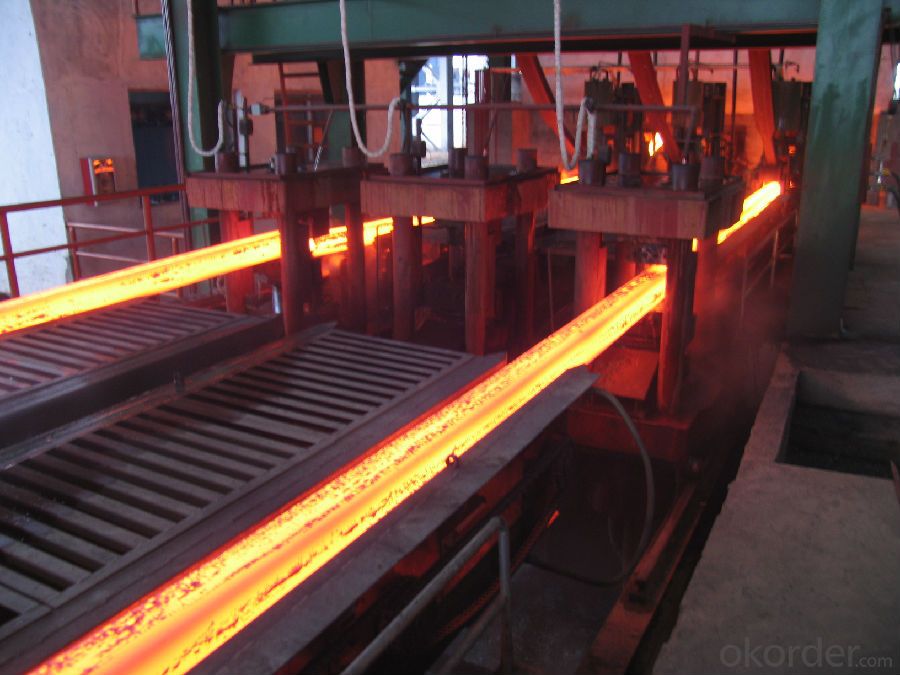
Specifications of Hot Rolled Square Steel Billet 3SP Standard 145mm
| Classified symbol | Yield Point Minimum N/mm2 | Tensile Strength Minimum | Elongation Minimum % | Application | ||||
| N/mm2 | Nominal Thickness mm (t) | |||||||
| JIS | Yogic | 0.25-0.4 | 0.4-0.6 | 0.6-1.0 | 1.0-1.6 | |||
| G3312 | specification | |||||||
| CGCC | CGCC | -205 | -270 | -20 | -21 | -24 | -24 | Commercial |
| CGCD | CGCD | --- | 270 | --- | 27 | 31 | 32 | Drawing |
| --- | CG340 | 245 | 340 | 20 | 20 | 20 | 20 | Structural |
| CGC400 | CG400 | 295 | 400 | 16 | 17 | 18 | 18 | Structural |
| CGC440 | CG440 | 335 | 440 | 14 | 15 | 16 | 18 | Structural |
| CGC490 | CG490 | 365 | 490 | 12 | 13 | 14 | 16 | Structural |
| CGC570 | CG570 | 560 | 570 | --- | --- | --- | --- | Structural |
| ASTM Designation | Yield Point Minimum | Tensile Strength Minimum | Elongation Minimum % | Application | Q/BQB 445-2004(China standard) | ASM A653/A653M | JISG 3312 | |
| ksi(MPa) | ksi(MPa) | TDC51D+Z | (CS TYPE A+Z) | CGCC | ||||
| A653(M)-99 CS TYPE A,B,C | --- | --- | --- | Commercial | TDC52D+Z | CGCD | ||
| A653(M)-99 FS | --- | --- | --- | Lock Forming | TS250GD+Z | (G250+Z) | - | |
| A653(M)-99 DS | --- | --- | --- | Drawing | TS300GS+Z | (G300+Z) | CGC 400 | |
| A653(M)-99 SS Grade33(230) | 33(230) | 45(310) | 20 | Structural | TS350GD+Z | (G350+Z) | CGC490 | |
| A653(M)-99 SS Grade37(255) | 37(255) | 52(360) | 18 | Structural | TS550GD+Z | (G550+Z) | CGC570 | |
| A653(M)-99 SS Grade40(275) | 40(275) | 55(380) | 16 | Structural | ||||
| A653(M)-99 SS Grade50(345) | 50(345) | 65(450) | 12 | Structural | ||||
| A653(M)-99 SS Grade80(550) | 80(550) | 82(570) | --- | Structural | ||||
FAQ of Hot Rolled Square Steel Billet 3SP Standard 145mm
We have organized several common questions for our clients,may help you sincerely:
1. How Can I Visit There?
Our company is located in Tianjin City, China, near Beijing. You can fly to Tianjin Airport Directly. All our clients, from home or aboard, are warmly welcome to visit us!
2. How Can I Get Some Sample?
We are honored to offer you sample.
3. Why choose CNBM?
1, ISO, BV, CE, SGS approved.
2, Competitive price and quality.
3, Efficient service team online for 24 hours.
4, Smooth production ability(50000tons/month) .
5, quick delivery and standard exporting package.
6, Flexible payment with T/T, L/C, Paypal, Kunlun bank, etc.
- Q: How are steel billets used in the manufacturing of shipbuilding parts?
- Steel billets play a crucial role in the manufacturing of shipbuilding parts. These billets are essentially semi-finished steel products, typically in the form of rectangular or square bars, that are used as raw material for further processing in shipbuilding. To begin with, steel billets are subjected to a process called rolling, where they are passed through a series of rollers to reduce their cross-sectional area and increase their length. This rolling process transforms the billets into long, thin sections of steel known as plates or sheets. These plates or sheets are then used to create various shipbuilding components, such as hulls, decks, bulkheads, and superstructures. After the rolling process, the steel plates or sheets are cut into desired sizes and shapes using cutting machines or torches. These cut pieces are then formed, bent, and welded together to form the required shipbuilding parts. For instance, the steel plates may be bent and welded to create curved sections for the ship's hull, or they may be formed into intricate shapes for other components. Moreover, steel billets are also used to produce forged shipbuilding parts. In this case, the billets are heated to a high temperature and then subjected to intense pressure to reshape the steel. This forging process results in stronger and more durable shipbuilding parts, which are often used for critical components like propeller shafts, crankshafts, and turbine blades. In summary, steel billets serve as the starting point in the manufacturing of shipbuilding parts. Through processes like rolling, cutting, forming, and forging, these billets are transformed into plates, sheets, and forged components that are used to construct the various structural and functional elements of ships.
- Q: How are steel billets used in the manufacturing of telecommunications equipment?
- Telecommunications equipment manufacturing relies heavily on steel billets, which serve as a crucial component. These billets act as the raw material that undergoes shaping and transformation to create various components used in telecommunications infrastructure. Primarily, steel billets are used in the production of towers and masts, providing the necessary support for antennas and other transmitting and receiving equipment. To ensure strength and stability, the billets are melted and then forged or rolled into the desired shape, forming the structural members of these towers. Moreover, steel billets are also essential in the manufacturing of cable trays and cable management systems. These components play a crucial role in organizing and protecting the extensive network of cables used in telecommunications systems. By processing and fabricating the billets into cable trays, brackets, and supports, a robust and durable solution is provided for managing the complex web of cables. Furthermore, steel billets find application in the production of enclosures and cabinets that house sensitive telecommunications equipment. These enclosures safeguard the equipment from environmental factors like dust, moisture, and temperature fluctuations. By molding and shaping the steel billets into the desired size and design, a sturdy and secure enclosure is achieved. In conclusion, the role of steel billets in telecommunications equipment manufacturing cannot be overstated. Whether it is for towers and masts, cable trays, or enclosures, these billets lay the foundation and ensure the structural integrity necessary for the reliable operation of telecommunications infrastructure.
- Q: How is the strength of steel billets measured?
- The strength of steel billets is typically measured using a tensile test, where a sample is subjected to pulling forces until it fractures. The maximum force applied during the test is recorded and used to determine the strength of the steel.
- Q: What are the specifications for tool steel billets used in the automotive industry?
- Tool steel billets used in the automotive industry must meet specific criteria to ensure their suitability for various applications. These criteria are essential to guarantee the desired performance and durability of the tool steel in automotive manufacturing processes. One crucial criterion for tool steel billets used in the automotive industry is their chemical composition. The tool steel needs to have a precise composition of elements like carbon, chromium, vanadium, and molybdenum, among others. These elements contribute to the steel's hardness, wear resistance, and toughness, which are vital properties for automotive tooling. Furthermore, the tool steel billets must fall within a specific range of hardness. Hardness can be measured using scales such as Rockwell or Brinell, and the desired level of hardness depends on the intended application. Tools that require high wear resistance generally prefer higher hardness, while tools that require toughness and impact resistance may tolerate lower hardness. Additionally, the tool steel billets used in the automotive industry must display excellent dimensional stability. This means that the steel should undergo minimal dimensional changes during heat treatment and manufacturing processes, ensuring that the tools maintain their shape and accuracy over time. Another important criterion is the machinability of the tool steel. It should be easy to machine and shape into the desired tooling components without excessive tool wear or difficulty. Good machinability allows for efficient production and reduces costs associated with tooling. Moreover, the tool steel billets used in the automotive industry should exhibit good thermal conductivity. This property enables the effective dissipation of heat generated during manufacturing processes like forging or heat treatment. Good thermal conductivity helps prevent localized overheating and ensures uniform heat distribution throughout the tool, resulting in consistent performance. Lastly, the tool steel billets should be free from defects and impurities that could compromise the integrity and performance of the tool steel. These defects include cracks, voids, inclusions, or any other imperfections. Typically, quality control measures such as non-destructive testing are implemented to ensure that the billets meet the required standards. In conclusion, the specifications for tool steel billets used in the automotive industry encompass factors such as chemical composition, hardness, dimensional stability, machinability, thermal conductivity, and overall quality. These specifications guarantee that the tool steel meets the specific requirements of automotive tooling applications, providing durability, performance, and reliability in automotive manufacturing processes.
- Q: What are the different steelmaking processes used for producing steel billets?
- There are several different steelmaking processes used for producing steel billets. Some of the common ones include the electric arc furnace (EAF) process, the basic oxygen furnace (BOF) process, and the continuous casting process. The EAF process involves melting scrap steel using an electric arc, while the BOF process involves blowing oxygen through molten iron to remove impurities. The continuous casting process involves continuously pouring molten steel into a water-cooled mold to form solid billets. Each process has its advantages and is used depending on factors such as cost, quality requirements, and availability of raw materials.
- Q: What is the average cost of steel billets?
- The average cost of steel billets can vary depending on factors such as the type, quality, quantity, and market conditions. It is recommended to check with steel suppliers or conduct market research to get the most accurate and up-to-date pricing information.
- Q: Are steel billets subject to any heat treatment processes?
- Indeed, heat treatment processes can be used on steel billets. Heat treatment is a regulated procedure that involves heating and cooling metals in order to modify their physical and mechanical properties. Steel billets, which are semi-finished steel products with a square or rectangular shape, can undergo different heat treatment processes depending on the desired properties for the final product. One commonly used heat treatment process for steel billets is annealing. Annealing consists of heating the billets to a specific temperature and gradually cooling them to relieve internal stresses and enhance their ductility and toughness. This process is typically employed to soften the steel and make it more malleable for subsequent manufacturing processes. Another heat treatment process for steel billets is quenching and tempering. Quenching involves rapidly cooling the heated steel billets in a liquid medium, such as oil or water, to achieve high hardness and strength. However, this process results in a hard but brittle material. To reduce the brittleness, the quenched billets are then tempered by reheating them to a lower temperature and slowly cooling them. Tempering improves the toughness and ductility of the steel while maintaining a certain level of hardness. Additional heat treatment processes that can be applied to steel billets include normalizing, which involves heating the steel above its critical temperature and then cooling it in still air to refine the grain structure, and stress relieving, which is performed to reduce residual stresses in the billets after extensive machining or welding. Overall, heat treatment processes can significantly improve the mechanical properties of steel billets, making them more suitable for various applications in industries such as automotive, construction, and manufacturing.
- Q: What are the different types of steel billet forging defects?
- There are several different types of steel billet forging defects that can occur during the forging process. These defects can have various causes and can impact the quality and integrity of the final forged product. Some of the common types of defects include: 1. Surface cracks: These are cracks that occur on the surface of the billet. They can be caused by excessive heating or cooling, improper forging techniques, or the presence of impurities in the steel. 2. Internal voids: These are cavities or voids that form within the billet. They can be caused by incomplete filling of the mold, improper venting, or the presence of gases trapped within the steel. 3. Inclusions: These are foreign materials or impurities that are present within the billet. They can include non-metallic particles, such as oxides or sulfides, or metallic impurities, such as slag. Inclusions can weaken the structure of the steel and reduce its overall quality. 4. Segregation: This refers to the non-uniform distribution of alloying elements within the billet. It can occur during the cooling process and can result in areas of the steel with different mechanical properties. This can lead to inconsistencies in the final product. 5. Dimensional inaccuracies: These defects refer to deviations from the desired shape or size of the billet. They can be caused by improper tooling or die design, inadequate heating or cooling processes, or improper handling during forging. 6. Grain structure abnormalities: The grain structure of the steel can be affected by various factors, such as improper heating or cooling rates. Abnormal grain structures can weaken the steel and reduce its mechanical properties. It is important to identify and address these defects during the production process to ensure the quality and reliability of the final forged product. Quality control measures, such as non-destructive testing and visual inspections, can help to detect and rectify these defects before the finished product is delivered to the customer.
- Q: Can steel billets be used in the production of mining equipment?
- Yes, steel billets can be used in the production of mining equipment. Steel billets are a common starting material for manufacturing various types of machinery and equipment, including those used in the mining industry. The high strength and durability of steel make it an ideal choice for mining equipment due to the demanding nature of mining operations. Steel billets can be forged, machined, and shaped into components or parts that are essential for mining equipment, such as gears, shafts, frames, and buckets.
- Q: How are steel billets used in the manufacturing of agricultural machinery?
- Agricultural machinery manufacturing heavily relies on steel billets as an indispensable element. These semi-finished steel products serve as the primary raw material for a wide range of parts and components used in agricultural machinery. The manufacturing process extensively utilizes steel billets for forging and casting purposes. Forging involves heating the billets to high temperatures and then shaping them using mechanical pressure. On the other hand, casting entails pouring molten metal into a mold. Both techniques enable the creation of intricate and long-lasting components, which are crucial for agricultural machinery. Steel billets find application in the production of various parts in agricultural machinery, including engine components, transmission gears, axles, and hydraulic cylinders. These parts necessitate exceptional strength, durability, and resistance to wear, all of which are provided by steel billets. Moreover, the high tensile strength of steel ensures that the machinery can endure the demanding conditions encountered in agricultural operations. Furthermore, steel billets are instrumental in the manufacture of frames and chassis for agricultural machinery. The frames must possess robustness to support weight and withstand the stress and vibrations experienced during operation. Steel billets enable the creation of sturdy and rigid frames, thereby ensuring the longevity and structural integrity of the machinery. Additionally, steel billets are employed in the production of cutting and harvesting tools, such as blades, discs, and plowshares. The exceptional hardness and sharpness of steel make it an ideal material for these tools, facilitating efficient and precise agricultural operations. In conclusion, steel billets occupy a pivotal role in the manufacturing of agricultural machinery. Their versatility, strength, and durability render them suitable for diverse components and parts, ensuring that the machinery can endure the demanding conditions encountered in agricultural operations and perform optimally.
Send your message to us
Hot Rolled Square Steel Billet 3SP Standard 145mm
- Loading Port:
- Shanghai
- Payment Terms:
- TT OR LC
- Min Order Qty:
- 2000 m.t.
- Supply Capability:
- 10000 m.t./month
OKorder Service Pledge
OKorder Financial Service
Similar products
Hot products
Hot Searches
Related keywords
